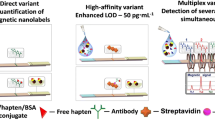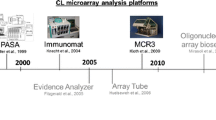Abstract
A protein array chip for label-free optical detection of low molecular weight compounds has been developed. As a proof of principle, the chip is proven capable of rapidly (approximately 1 min) determining hits from aqueous cocktails composed of four common narcotics, cocaine, ecstasy, heroin, and amphetamine, using imaging surface plasmon resonance (SPR) as the detection principle. The chip is produced by injecting a mixture of antibodies and letting them self-sort and bind to narcotic analog coupled proteins already present in a predefined pattern on the supporting substrate. An indirect detection method, where antibodies are displaced from the surface upon recognition of their corresponding narcotics, is used to obtain the optical contrast and thus a detectable SPR and/or ellipsometric signal. Two types of readouts are possible from the present setup: intensity SPR images and SPR/ellipsometric sensorgrams. Positive hits were routinely obtained for analyte concentrations of 50 pg/μL and the limit of detection, without any parameter optimizations, seems to fall in the range 0.5 pg/μL (1.4 nM) for heroin, 2.5 pg/μL (8.2 nM) for cocaine, and 5 pg/μL for the other two narcotics (26 nM for ecstasy and 37 nM for amphetamine). With improved readout possibilities (sampling frequency), signal evaluation algorithms, and antibody–antigen design strategies, we believe this limit can be further improved. The chip is shown to work for many measurement cycles with excellent reproducibility. Moreover, with a more advanced fluidic system, excess injected antibodies could be collected and reused for many cycles, which could make the running costs of the system very low. The chip is in no way limited to detection of narcotics. Other low molecular weight compounds could easily be detected on the same chip. For example, trinitrotoluene detection has already been demonstrated using our chip. Possible areas of application for the system are therefore envisaged in airport and underground transport security, customs, drug interdiction, forensics, and as warning alerts on military equipment and personnel.

Narcotics chip (left) composed of spots of piezodispensed analog-coupled proteins that are loaded with antibodies to form a patterned regions represented by the capital letter of the four different narcotics in focus. (Right) The same chip showing hits for ectasy and herion in the cocktail. Both images are obtained in imaging surface plasmon resonance mode







Similar content being viewed by others
References
United Nations, Office on Drugs and Crime (2006) World drug report 2006. Volume I, analysis. United Nations, Office on Drugs and Crime, New York
Moore D (2004) Rev Sci Instrum 75:2499
Revercomb HE, Mason EA (1975) Anal Chem 47:970
Wu C, Siems W, Hill H (2000) Anal Chem 72:396
Collins D, Lee M (2002) Anal Bioanal Chem 372:66
Keller T, Miki A, Regenscheit P, Dirnhofer R, Schneider A, Tsuchihashi H (1998) Forensic Sci Int 94:55
Van Nimmen N, Poels K, Veulemans H (2004) J Chromatogr B 804:375
Clauwaert K, VanBocxlaer J, Lambert W, DeLeenheer A (1996) Anal Chem 68:3021
Devine PJ, Anis NA, Wright J, Kim S, Eldefrawi AT, Eldefrawi ME (1995) Anal Biochem 227:216
Halamek J, Makower A, Skladal P, Scheller F (2002) Biosens Bioelectron 17:1045
Davies DR, Padlan EA, Sheriff S (1990) Annu Rev Biochem 59:439
Klenkar G, Valiokas R, Lundstrom I, Tinazli A, Tampe R, Piehler J, Liedberg B (2006) Anal Chem 78:3643
MacBeath G, Schreiber S (2000) Science 289:1760
Templin M, Stoll D, Schrenk M, Traub P, Vohringer C, Joos T (2002) Trends Biotechnol 20:160
Zhu H, Bilgin M, Bangham R, Hall D, Casamayor A, Bertone P, Lan N, Jansen R, Bidlingmaier S, Houfek T, Mitchell T, Miller P, Dean R, Gerstein M, Snyder M (2001) Science 293:2101
Zhu H, Snyder M (2001) Curr Opin Chem Biol 5:40
Sapsford K, Charles P, Patterson C, Ligler F (2002) Anal Chem 74:1061
Holt DB, Kusterbeck AW, Ligler FS (2000) Anal Biochem 287:234
Rabbany SR, Piervincenzi RT, Kusterbeck AW, Bredehorst R, Ligler FS (1998) Anal Lett 31:1663
Shriver-Lake LC, Charles PT, Kusterbeck AW (2003) Anal Bioanal Chem 377:550
Love J, Estroff L, Kriebel J, Nuzzo R, Whitesides G (2005) Chem Rev 105:1103
Wink T, vanZuilen SJ, Bult A, vanBennekom WP (1997) Analyst 122:R43
Pardo L, Wilson W, Boland T (2003) Langmuir 19:1462
Roda A, Guardigli M, Russo C, Pasini P, Baraldini M (2000) Biotechniques 28:492
Mrksich M, Whitesides G (1996) Annu Rev Biophys Biomol Struct 25:55
Roach P, Farrar D, Perry C (2005) J Am Chem Soc 127:8168
Johansen K, Arwin H, Lundstrom I, Liedberg B (2000) Rev Sci Instrum 71:3530
Nelson B, Frutos A, Brockman J, Corn R (1999) Anal Chem 71:3928
Månsson P, Johansson A-S, Sandén B, Loniakan S (2003) Coated metal surface on solid support useful in analyte detection by displacement. Patent WO/2004/001416
Raether H (1988) Surface plasmons on smooth and rough surfaces and on gratings. Springer, Berlin
Abelès F (1976) Surf Sci 56:237
Poksinski M, Arwin H (2004) Thin Solid Films 455–456:716
Westphal P, Bornmann A (2002) Sens Actuators B 84:278
Rothenhausler B, Knoll W (1988) Nature 332:615
Mezzasoma L, Bacarese-Hamilton T, Di Cristina M, Rossi R, Bistoni F, Crisanti A (2002) Clin Chem 48:121
Myszka DG (1999) J Mol Recognit 12:279
Narang U, Gauger PR, Kusterbeck AW, Ligler FS (1998) Anal Biochem 255:13
Duda R, Hart PE, Stork DG (2001) Pattern classification, 2nd edn. Wiley, New York
Jain A, Duin R, Mao J (2000) IEEE Trans Pattern Anal 22:4
Pearce TC, Schiffman SS, Nagle HT, Gardner JW (2003) Handbook of machine olfaction: electronic nose technology. Wiley-VCH, Weinheim
Acknowledgements
This research was supported by the Wallenberg Consortium North (WCN), the Swedish Research Counsil (VR), and the Swedish Foundation for Strategic Research (SSF) through the Biomimetic Materials Science and NanoSense programs. We also thank Per Månsson and Ann-Charlotte Hellgren at Biosensor Applications AB for supplying the protein conjugates, antibodies, and narcotic cocktails.
Author information
Authors and Affiliations
Corresponding author
Rights and permissions
About this article
Cite this article
Klenkar, G., Liedberg, B. A microarray chip for label-free detection of narcotics. Anal Bioanal Chem 391, 1679–1688 (2008). https://doi.org/10.1007/s00216-008-1839-9
Received:
Revised:
Accepted:
Published:
Issue Date:
DOI: https://doi.org/10.1007/s00216-008-1839-9




